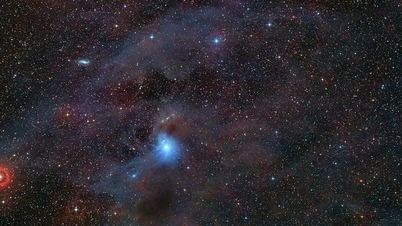Signs of life outside Earth

Spacecraft finds potential for long-term life on Enceladus, one of Saturn's moons (Illustration: ESA).
A groundbreaking study based on old data from the Cassini probe has just announced the discovery of unusual heat leaking from the north pole of Enceladus, one of Saturn's moons.
This discovery opens a new door to the possibility of extraterrestrial life, showing that the ocean under Enceladus' thick ice layer may have maintained energy stability for billions of years.
Enceladus has long been considered an active ocean world in the Solar System, especially after the Cassini mission detected giant plumes of water vapor erupting from its south pole in 2005.
The energy source for these jets is determined to be tidal heating, the result of the gravitational interaction between Saturn and Enceladus, causing the satellite's core to be constantly compressed and stretched, generating heat and maintaining a liquid state under a layer of ice tens of kilometers thick.
But the big question remains: could this ocean survive long enough for life to form? By comparing data from Cassini’s Composite Infrared Spectrometer (CIRS) between the winter of 2005 and the summer of 2015, the team found that temperatures at the north pole were about 7°C higher than models predicted, suggesting an excess heat source escaping from within.
This amount of heat is estimated at 46 milliwatts/m², equivalent to two-thirds of the heat lost on the Earth's continents.
This suggests a delicate energy balance that allows underground oceans to remain stable over long geological times, a key factor for life to develop.
The key to longevity

Illustration of planets orbiting stars in the Milky Way (Illustration: NASA).
Previously, Enceladus's north pole was thought to be a "dead zone" with no significant geological activity. However, the new results prove otherwise, showing that heat is diffused globally and strengthening the possibility of a continuous, connected ocean under the 20-28 km thick ice sheet.
Understanding Enceladus' global heat balance is "key to determining its long-term habitability," says Carly Howett, a researcher at the University of Oxford and the Arizona Planetary Science Institute.
The discovery not only raises hopes for a habitable world, but also proves that data from Cassini, even though its mission ended in 2017, continues to reveal new discoveries.
Miles stressed that “deciphering the tiny temperature variations on the surface of Enceladus” is a testament to the importance of long-term space missions, as “there are secrets that only emerge decades after the data is collected.”
The European Space Agency (ESA) is currently considering a mission to explore Enceladus in the 2040s, with the goal of learning more about its underground ocean and the organic compounds inside.
If launched, it could be the next step in the search for extraterrestrial life, a journey for which Enceladus is emerging as the most promising candidate in the Solar System.
Source: https://dantri.com.vn/khoa-hoc/nguon-song-tiem-an-ben-duoi-mat-trang-cua-sao-tho-20251109095229052.htm







![[Photo] Deep sea sand deposits, ancient wooden ship An Bang faces the risk of being buried again](https://vphoto.vietnam.vn/thumb/1200x675/vietnam/resource/IMAGE/2025/11/13/1763033175715_ndo_br_thuyen-1-jpg.webp)
















![[INFOGRAPHIC] Soundcore AeroClip, overturning stereotypes about open-ear headphones](https://vphoto.vietnam.vn/thumb/402x226/vietnam/resource/IMAGE/2025/11/13/1763040979357_thumb-tai-nghe-ear-jpg.webp)














































































![Dong Nai OCOP transition: [Article 3] Linking tourism with OCOP product consumption](https://vphoto.vietnam.vn/thumb/402x226/vietnam/resource/IMAGE/2025/11/10/1762739199309_1324-2740-7_n-162543_981.jpeg)







Comment (0)